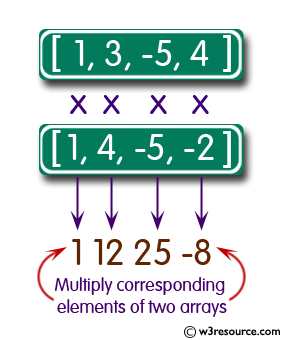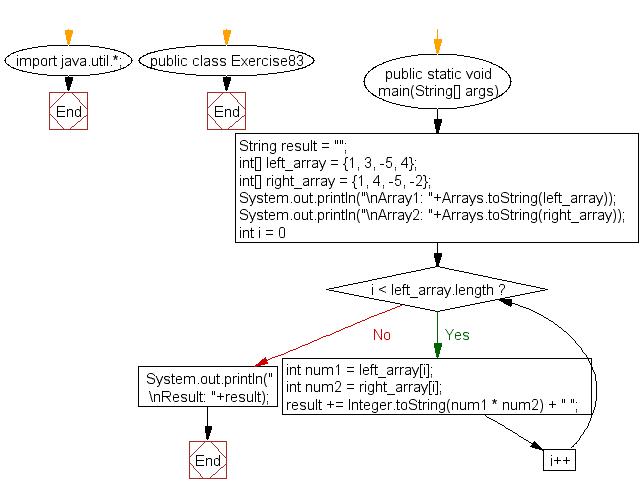Java Exercises: Multiply corresponding elements of two arrays of integers
Java Basic: Exercise-83 with Solution
Write a Java program to multiply corresponding elements of two arrays of integers.
Sample Solution:
Java Code:
import java.util.*;
public class Exercise83 {
public static void main(String[] args){
String result = "";
int[] left_array = {1, 3, -5, 4};
int[] right_array = {1, 4, -5, -2};
System.out.println("\nArray1: "+Arrays.toString(left_array));
System.out.println("\nArray2: "+Arrays.toString(right_array));
for (int i = 0; i < left_array.length; i++) {
int num1 = left_array[i];
int num2 = right_array[i];
result += Integer.toString(num1 * num2) + " ";
}
System.out.println("\nResult: "+result);
}
}
Sample Output:
Array1: [1, 3, -5, 4]
Array2: [1, 4, -5, -2]
Result: 1 12 25 -8
Pictorial Presentation:

Flowchart:

Java Code Editor:
Contribute your code and comments through Disqus.
Previous: Write a Java program to find the largest element between first, last, and middle values from an array of integers .
Next: Write a Java program to take the last three characters from a given string and add the three characters at both the front and back of the string.
What is the difficulty level of this exercise?
Test your Programming skills with w3resource's quiz.
Java: Tips of the Day
How to sort an ArrayList?
Collections.sort(testList); Collections.reverse(testList);
That will do what you want. Remember to import Collections though!
Ref: https://bit.ly/32urdSe
- New Content published on w3resource:
- HTML-CSS Practical: Exercises, Practice, Solution
- Java Regular Expression: Exercises, Practice, Solution
- Scala Programming Exercises, Practice, Solution
- Python Itertools exercises
- Python Numpy exercises
- Python GeoPy Package exercises
- Python Pandas exercises
- Python nltk exercises
- Python BeautifulSoup exercises
- Form Template
- Composer - PHP Package Manager
- PHPUnit - PHP Testing
- Laravel - PHP Framework
- Angular - JavaScript Framework
- Vue - JavaScript Framework
- Jest - JavaScript Testing Framework
